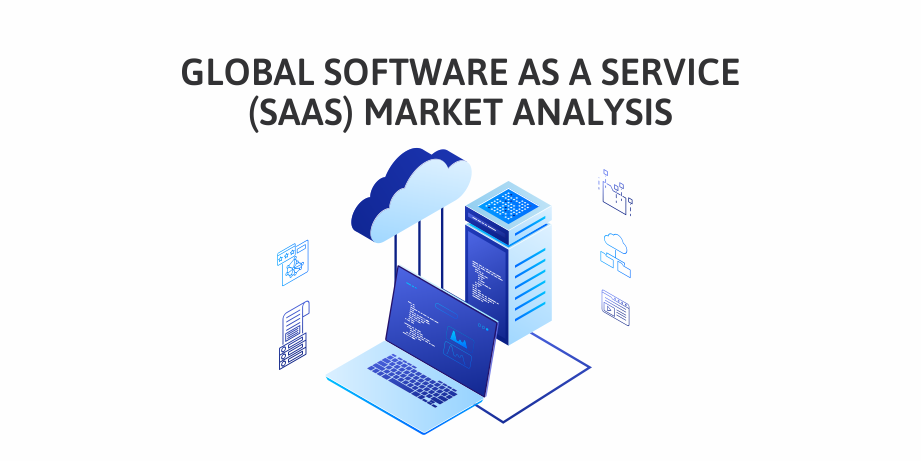SaaS trends are slowly dominating in every industry since it’s a flexible and effective solution that improves performance while minimizing app cost. Cloud-based apps with the SaaS business model provide companies with a number of benefits and give an option for many businesses to step back from the traditional installation.
The high demand for software-as-a-service solutions creates an equally high demand to enter and adapt to the global SaaS market. If you are wondering how hard is to launch a new SaaS product, let’s review this SaaS industry report including market snapshot, trends, and top companies. Working with over 25 SaaS startups, we structured our knowledge and practice within this article.
What is SaaS?
Software-as-a-Service application is the part of the cloud application services, focusing on SaaS products, apps, and platforms for SMB, SME and large enterprises worldwide.
How does SaaS work? SaaS allows you to access an application via an Internet browser which is managed by a third-party vendor, to its users. A majority of the SaaS applications run directly through the web browser, which means they do not require any downloads or installations on the client’s side. Basically, SaaS freeing you from complex software and hardware management, since you don’t have to download software to your PC or business network to run and update.
You can think of the SaaS model as a bank that provides services and at the same time protects the privacy of each user. A bank’s customers all use the same financial systems and technology without worrying about anyone accessing their personal information without authorization. It proves the SaaS growth rate and the fact that 78% of respondents stated their companies would run on the SaaS platform by 2022, according to a BetterCloud survey.
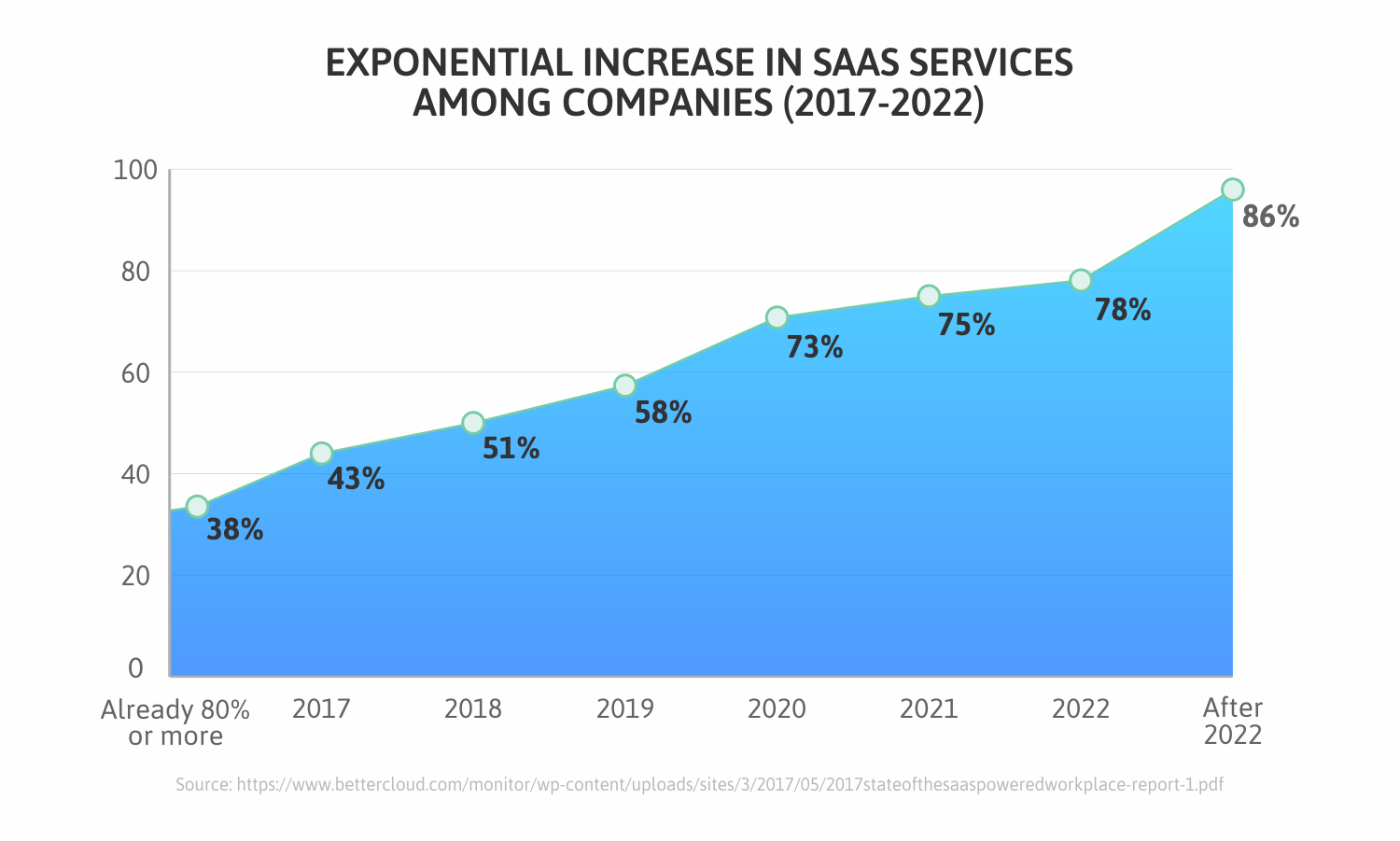
Models of Cloud Service
There are three different models of cloud service: Software as a Service (SaaS), Platform as a service (PaaS), and Infrastructure as a service (IaaS). Each of them has their own characteristics and benefits.
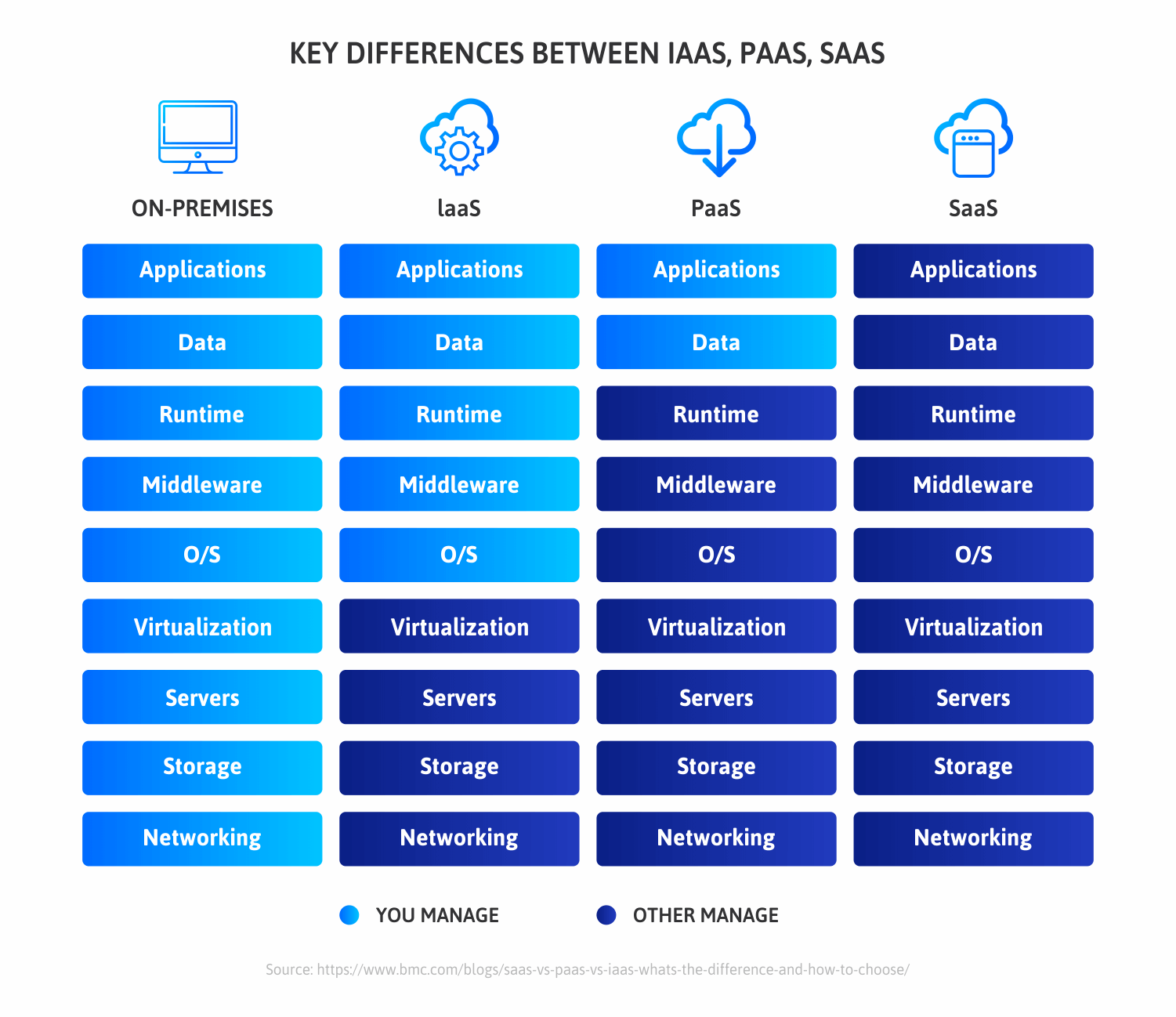
SaaS
Software as a Service is characterized by the web delivery model that eliminates the obligation to install the app on each device. With SaaS vendors manage all potential technical issues, such as data, servers, and storage resulting in support of the business. Reduce time and money spend on tiresome tasks like installing, managing and updating software.
The best way to use SaaS is for small businesses and startups that need to launch eCommerce quickly and don’t have time for server issues or software. Short-term projects that require easy and affordable collaboration. SaaS solution will be perfect in case there needed both web and mobile access.
Google GSuite (Apps), Dropbox, Salesforce, Cisco WebEx, SAP Concur, and GoToMeeting are several popular examples of SaaS.
PaaS
Platform as a Service is a simple and cost-effective cloud component that provides certain software while being used mainly for apps. PaaS delivers a certain framework for developers to create customized apps. The servers and networking can be managed by the enterprise or a third-party provider while the developers can maintain the management of the app.
PaaS can streamline workflows when multiple developers are working on the same development project. If other vendors must be included. PaaS can provide great speed and flexibility to the entire process. PaaS is the right choice for creating customized applications. It can greatly reduce costs and simplify certain challenges during the development process.
Some popular examples of PaaS include AWS Elastic Beanstalk, Windows Azure, Heroku, Force.com, Google App Engine, and OpenShift.
IaaS
Cloud infrastructure services are fully self-service for accessing and monitoring computers, networks, and services. IaaS allows businesses to purchase resources on-demand and as-need instead of having to buy the hardware outright.
Startups and small businesses can choose IaaS to save money and time on purchasing and developing hardware and software. Larger companies may prefer to retain complete control over their apps, but they want to purchase only what they actually need. Companies experiencing rapid growth can change the specific hardware and software easily as they needs.
The companies using IaaS include DigitalOcean, Linode, Rackspace, Amazon Web Services (AWS), Cisco Metacloud, and Google Compute Engine (GCE).

Types of SaaS Apps
Moreover, SaaS applications categorize from messaging software, financial ledgers, customer relationship management applications to gamification, virtualization, or learning management systems. Precisely, there are various types of SaaS applications, such as:
Web Hosting and E-Commerce — SaaS applications enable business on the web, from content management systems (CMS) and message boards to web hosting and shopping carts;
Communication Platforms — Include instant messaging and file-sharing software to enhance collaboration for teams;
Customer Relationship Management (CRM) — Tool for managing customer information, tracking sales, and automating marketing functions;
Accounting — Helps to keep track of your firm’s finances;
Payment Gateways — These applications based on the SaaS model include accepting credit cards, processing bank transfers, run offers and rewards programs, and publish and track coupons among others;
Human Resources — SaaS products which enable organizations to track employee hours, automate payroll processes, schedule interviews and streamline the hiring process are quite popular worldwide;
Project Management — SaaS products offer end to end project management solutions for processes such as composing plans to listing requirements and tracking progress with respect to deadlines and deliverables.
SaaS Clasification
Moreover, we can divide SaaS-based software and companies into a few types as follows:
Vertical SaaS stands for a specific market, end-user, pain points, and designed specifically for one particular industry, such as banking, healthcare, financial and insurance, information technology, and telecommunication, education, etc..
Horizontal SaaS, on the other hand, stands for wide usage, multiple end-users, and designed for various industries to utilize the product in the same way, like email platforms, chatbots, etc..
B2B SaaS companies offer their products to other companies only. B2B SaaS software trends are related to that particular company-to-company sphere.
B2C SaaS companies provide their services and goods to customers directly.
Overview of SaaS Market Size
The world is shifting to SaaS no matter how we look at it. This section provides a glimpse into the future and will help you to know how SaaS market growth would innovate the tech industry in the upcoming years.
The global business ecosystem has been greatly reshaped by cloud-driven products. Thus, as one of the leading and most promising cloud computing branches, SaaS has significantly transformed the way most businesses operate.
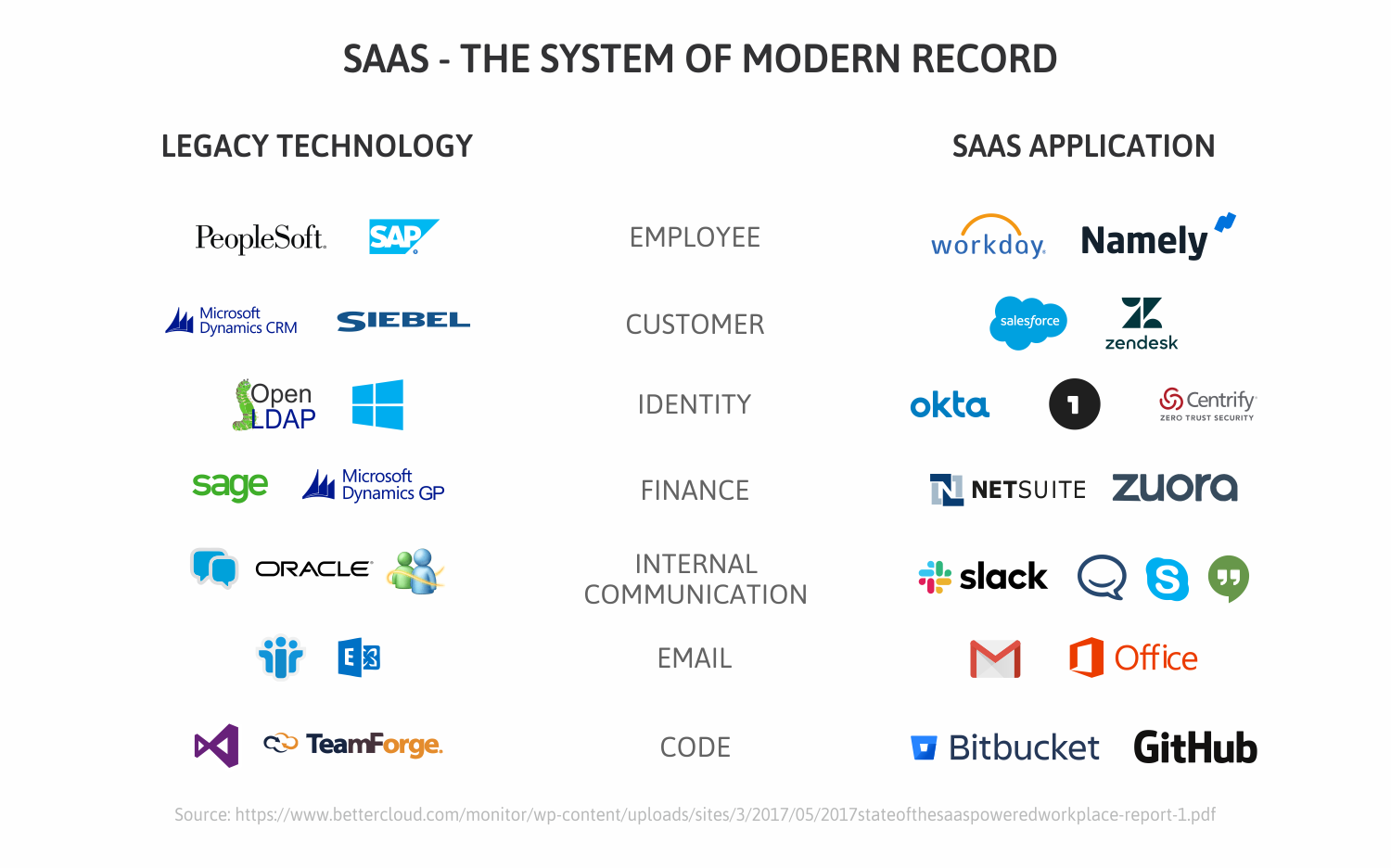
The emergence and penetration of messaging applications, emails, and video calls for private and business needs have made the end-users to depend on smartphones and tablets. Therefore, a growing number of end-users are looking for remote access at affordable costs, as a result, influencing the demand for SaaS solutions.
Based on Deployment Type, the market is segmented into:
Public Cloud refers to the cloud computing model with which the IT services are delivered across the Internet. The computing functionality may range from common services such as email, apps and storage to the enterprise-grade OS platform or infrastructure environments used for software development and testing. The cloud vendor is responsible for developing, managing and maintaining the pool of computing resources shared between multiple tenants from across the network. The defining features of a public cloud solution include high elasticity and scalability for IT-enabled services delivered at a low-cost subscription-based pricing tier.
Private Cloud refers to the cloud solution dedicated for use by a single organization. The data center resources may be located on-premise or operated by a third-party vendor off-site. The computing resources are isolated and delivered via a secure private network, and not shared with other customers. A private cloud is customizable to meet the unique business and security needs of the organization.
Hybrid Cloud refers to the cloud infrastructure environment that is a mix of public and private cloud solutions. The resources are typically orchestrated as an integrated infrastructure environment. Apps and data workloads can share the resources between public and private cloud deployment based on organizational business and technical policies around security, performance, scalability, cost and efficiency, among other aspects.
Industry snapshot
According to the SaaS industry report made by Forbes in 2018 public cloud platform adoption was highest in services companies (28%), with engineering (30%) and government (29%) having the highest adoption of private clouds. Private cloud-only adoption was lowest in services companies (16%) due to concerns over IT security skills.
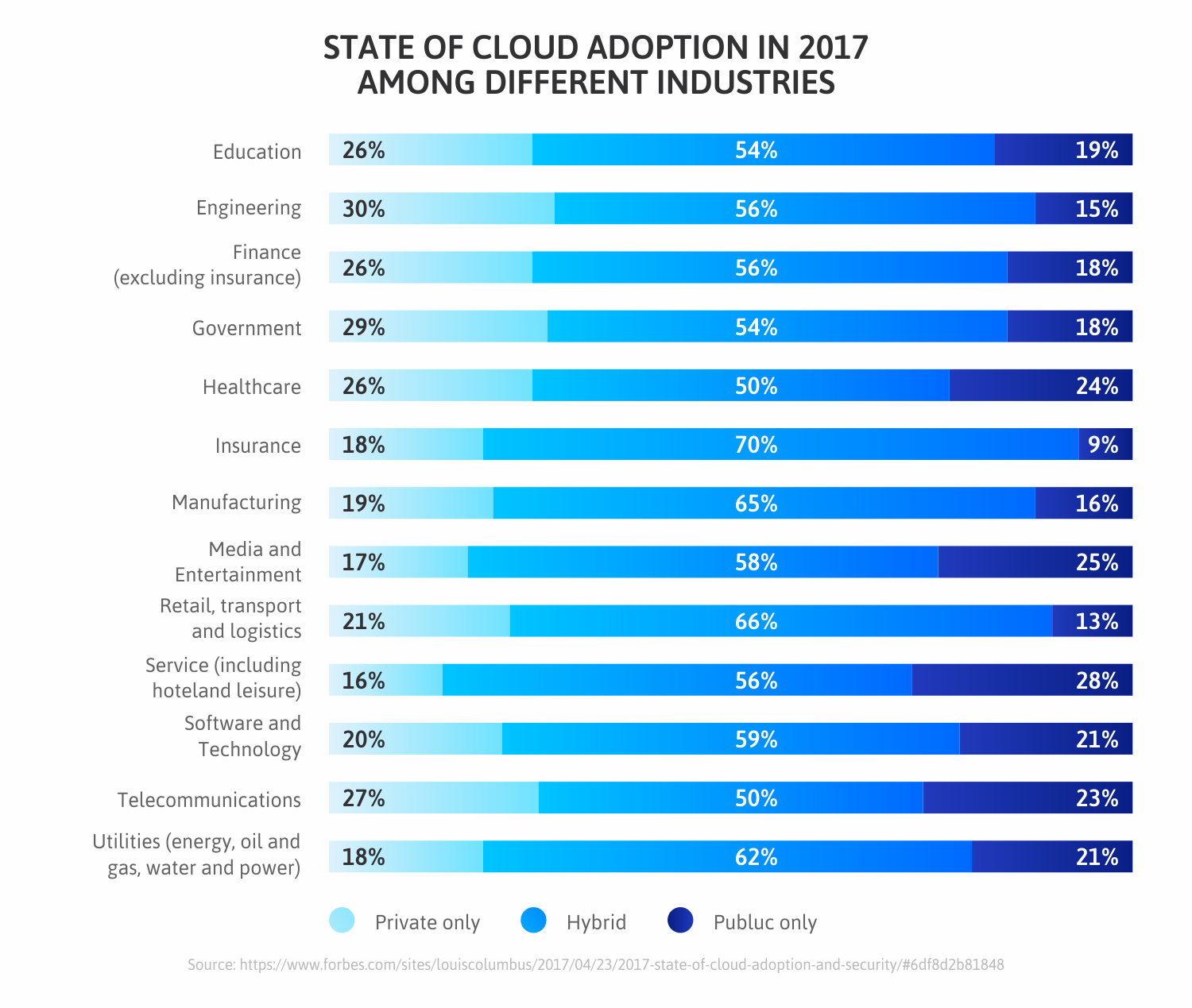
The current situation shows that whether you’re a public scale cloud business or a fledgling startup if you’re not focused on modern technological solutions you’ll be left behind.
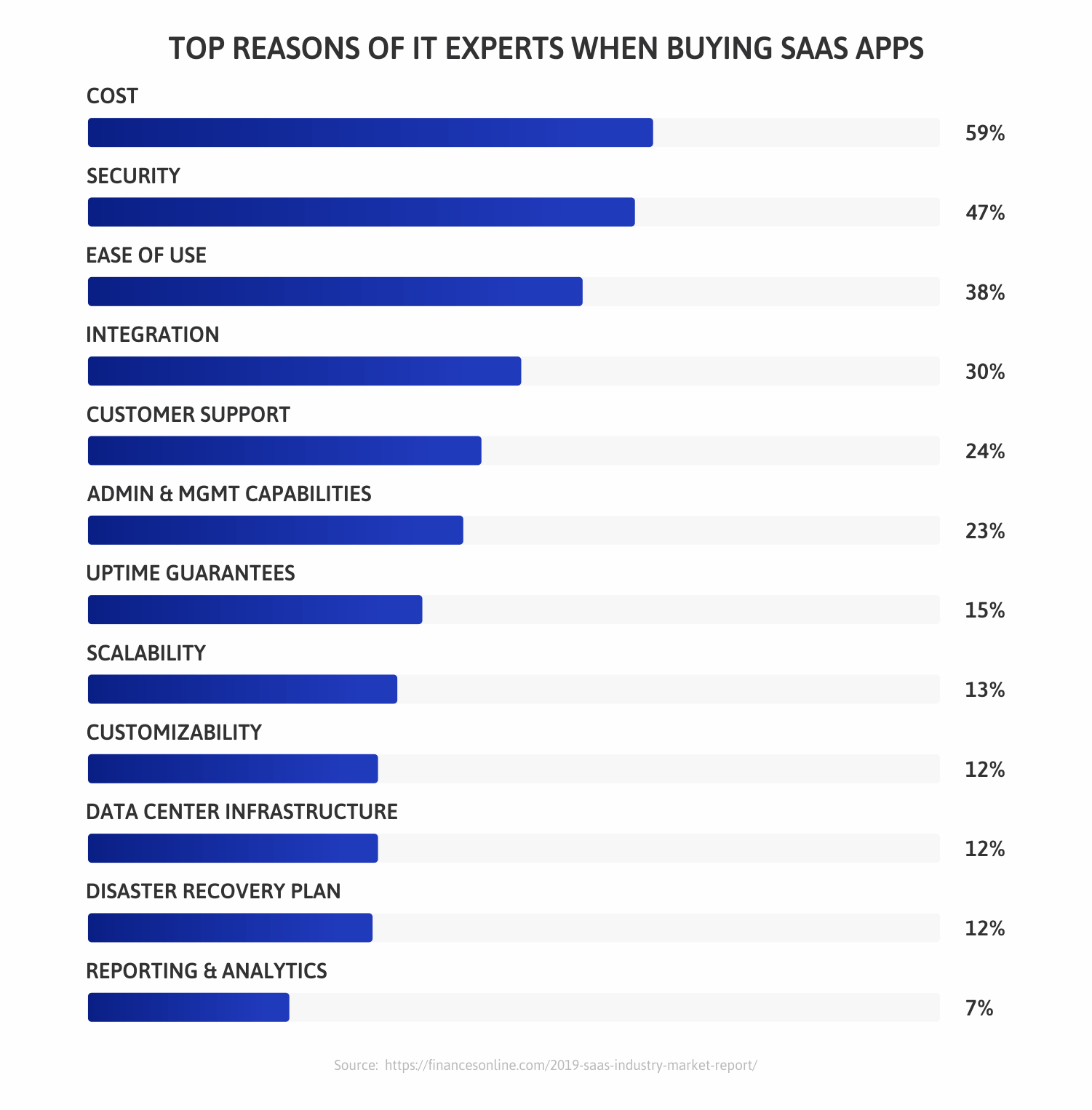
Geographical market snapshot
The software as a service market has been geographically segmented into North America, Western Europe, Asia-Pacific, Eastern Europe, South America and Middle East & Africa.
North America is the most mature market in terms of cloud computing services adoption, due to several factors, such as the presence of many enterprises with advanced IT infrastructure, and availability of technical expertise.APAC is expected to offer significant growth opportunities for cloud computing vendors during the forecast period. Rapid advancements in emerging technologies, IT infrastructure services, and the Internet of Things (IoT) have led many organizations to adopt cloud computing services.
The Key Players
SaaS aims to benefit businesses, helping companies attract and retain customers while boosting service. They have found tons of applications in different industries, specifically in the areas of marketing, sales, and customer service. This development has greatly contributed to the increase in the SaaS market size.
SaaS has also been experiencing growth in the B2B sector, making use of technologies such as machine learning and AI to improve automation further. There are likewise SaaS tools for small businesses that can help them compete with larger companies.
To keep up with the very purpose of SaaS, vendors have been designing their tools to blend well with different software environments through vast arrays of integrations and APIs.
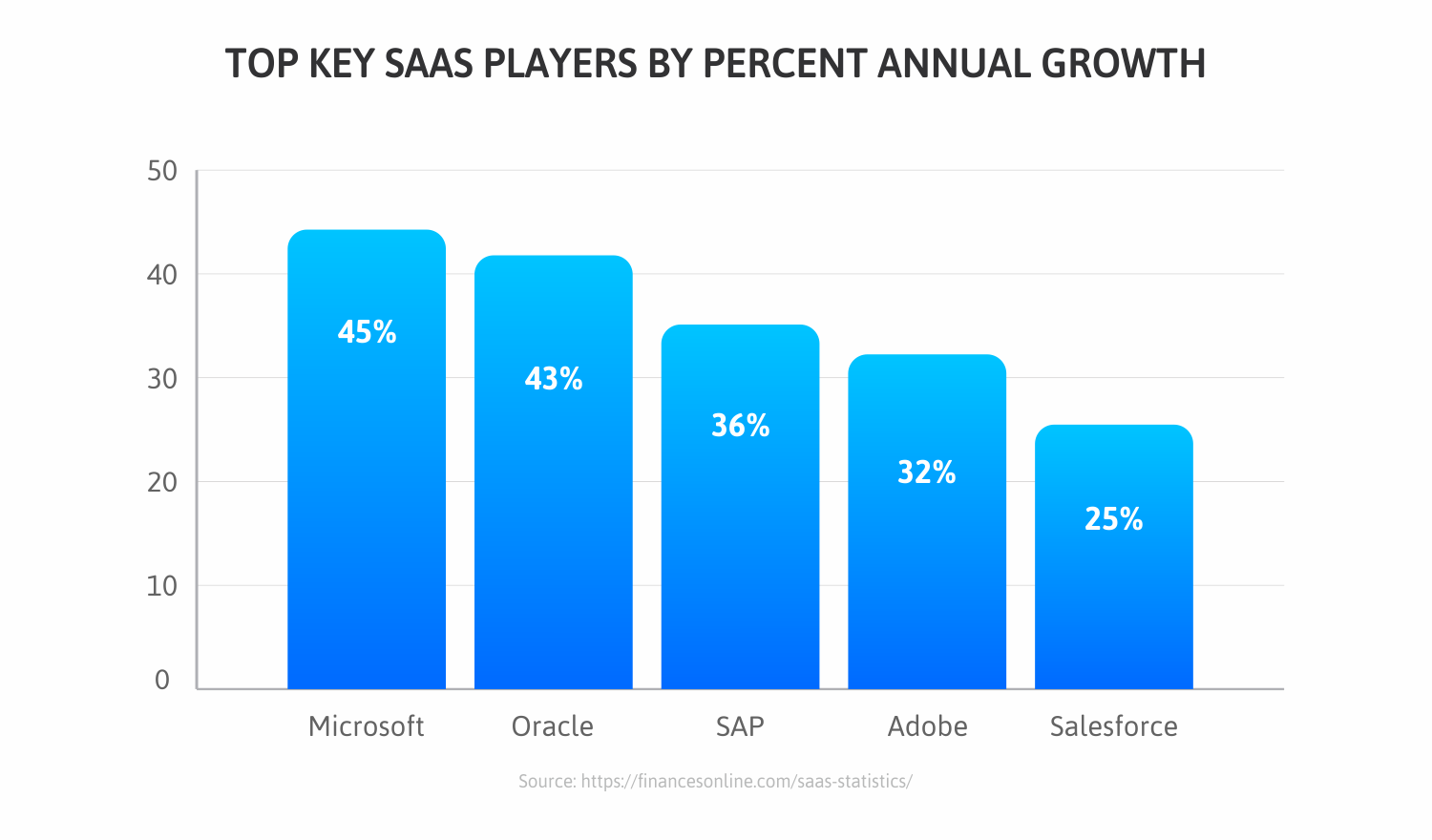
Among the top SaaS companies by revenue, Microsoft has a worldwide market share and is now the leading SaaS vendor. Microsoft's annual revenue growth is running at 45%, which makes a18% market share. Oracle, SAP and Adobe are followed after Microsoft, with Oracle achieving the highest growth rate among these three. Salesforce remains the dominant player in CRM, but this segment is relatively low growth compared to other SaaS segments. In aggregate these top five SaaS vendors now account for just over half of the market.
Markets are down (although back up a bunch!), but SaaS is down less than the overall market. Public saas co valuation multiple is currently 8.2xARR. Using our methodology, the average small, private SaaS company is therefore worth about 5.9x. https://t.co/U6fgMIKUa1
— Rob Belcher (@rob_belcher) April 16, 2020
How fast is SaaS growth rate?
It was expected that the public cloud SaaS market would reach 157 billion U.S. dollars in size in 2020, more than doubling the market size in 2014 (see graph below).
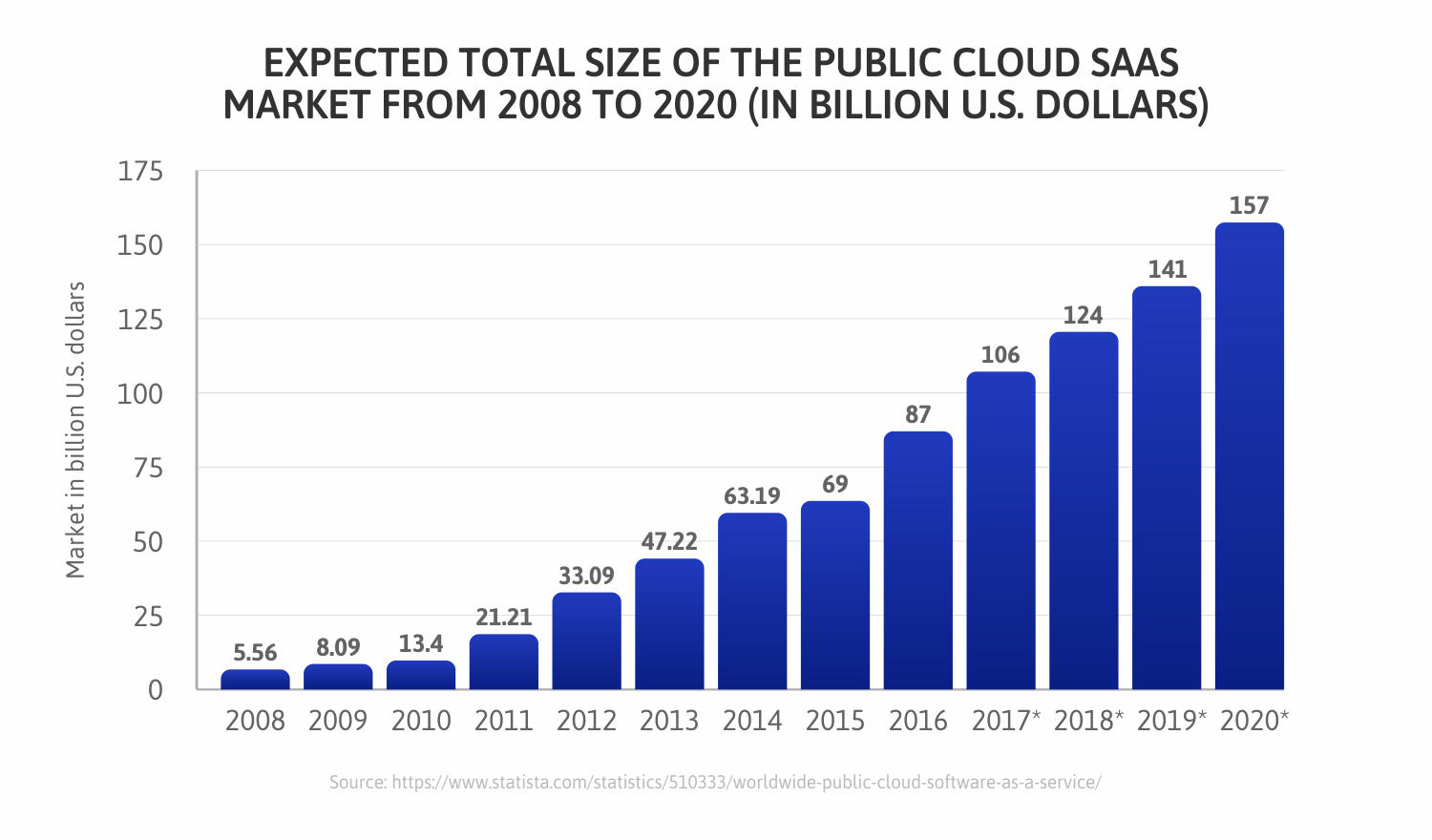
Talking about the SaaS market size from a global perspective - it continues to enjoy robust growth, with the sector seen to reach a total value of $623.3 billion by the year 2020, showing by far the most notable global Saas growth statistics. Saas market research has also revealed that businesses and organizations’ push for increased agile and automated processes will fuel this growth.
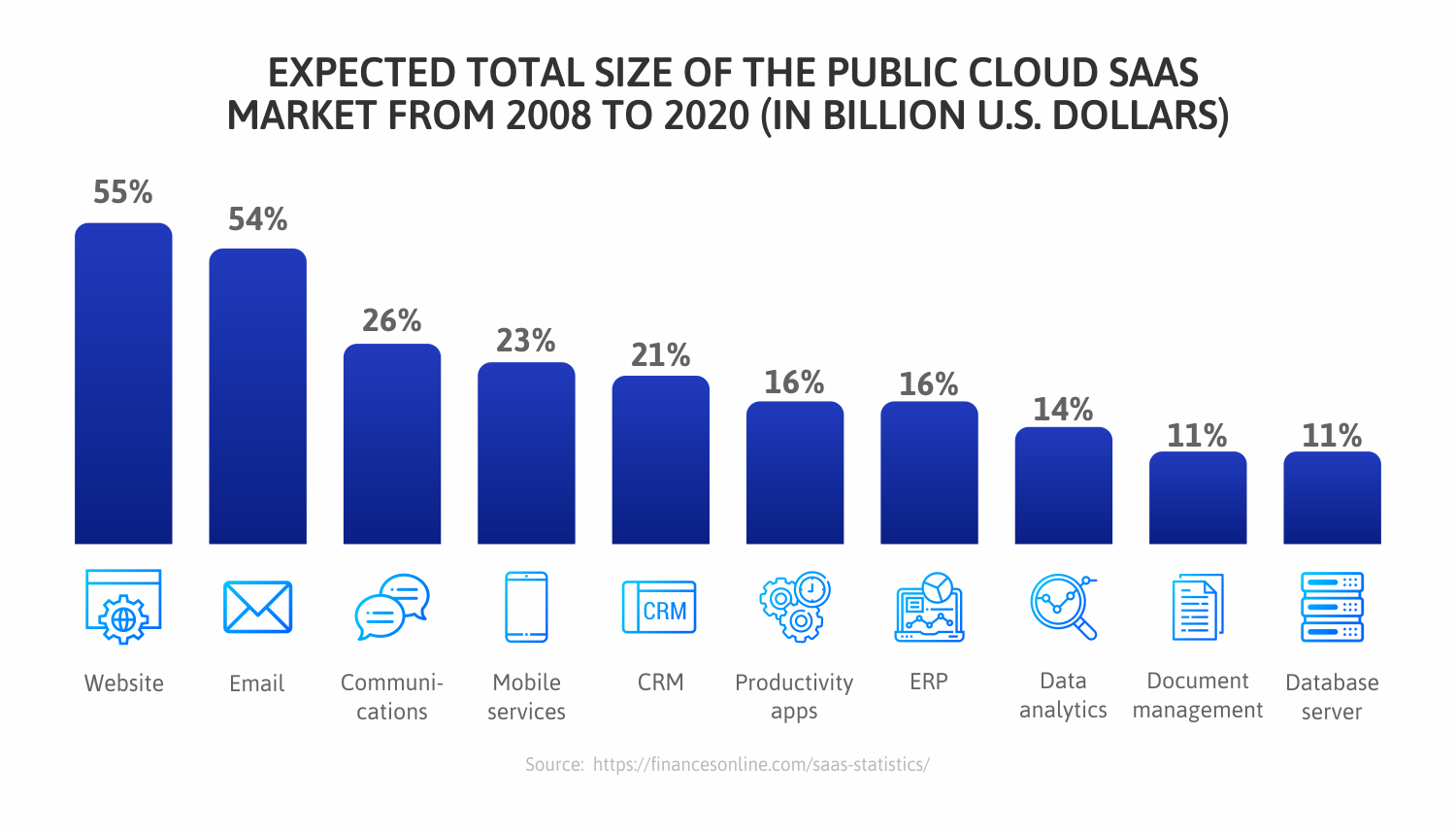
It is undeniable that SaaS has changed the global business landscape. For companies, cloud computing proved to be a boon, allowing them to harness the power of automation without breaking the bank. Some have claimed that these platforms made their organizations more successful compared to other types of systems, while others have decided to embrace the technology fully.
SaaS Solution - Revolutionary Approach in a Business
Once we have a slightly better understanding of the SaaS market growth, let’s discuss the main advantages of the SaaS apps for the business. Recently SaaS is becoming a popular method for companies of all sizes to offload the management of many different types of applications.
We've updated the SaaS Capital public saas company valuation index through 5/31/20. Some pretty dramatic moves over the last couple months, and surprising market highs across all businesses, not just SaaS. https://t.co/D0n2cDl8ki
— Rob Belcher (@rob_belcher) June 5, 2020
The main SaaS characteristics include:
Multitenant Architecture. A multitenant architecture, in which all users and applications share a single, common infrastructure and code base that is centrally maintained. Because SaaS vendor clients are all on the same infrastructure and code base, vendors can innovate more quickly and save the valuable development time previously spent on maintaining numerous versions of outdated code.
Easy Customisation. The ability for each user to easily customize applications to fit their business processes without affecting the common infrastructure. Because of the way SaaS is architected, these customizations are unique to each company or user and are always preserved through upgrades. That means SaaS providers can make upgrades more often, with less customer risk and much lower adoption cost.
Better Access. One strong advantage of any SaaS application is the ability to run through an internet browser, so it doesn't matter which Operating System is used to access it. So regardless of whether the user is trying to run the application on Windows, Mac, or Linux machines (or even smartphones running Android or iOS), the application still remains accessible. This makes SaaS applications incredibly versatile in a couple of different ways.
Indeed, it means you don't need to worry if your operating system or other software will be compatible with SaaS applications. Perhaps more importantly, not only can they be used in the office on desktop computers, but they can also be used on mobile devices such as tablets. SaaS applications are overwhelmingly designed to be mobile-friendly so that they can be used in a whole range of situations and circumstances, not least on the go.
Saving and storage. On-premise storage of data means the need to invest in reliable backups such as through online cloud storage or other disaster recovery plan to mitigate any serious hardware crash that might otherwise cause a significant loss of data. However, with SaaS, data is routinely saved in the cloud anyway. What makes this double advantageous is not just the redundancy aspect, but also that employees can switch between devices without losing work or data, simply by the fact of logging into the single account, regardless of which device is being used.
Data and analytics. Because everything is run through a centralized platform this means it's easy to capture data and provide it for analytics use. Businesses using SaaS software usually have access to reporting and intelligence tools and visualizations that can provide valuable insights into business operations, allowing for workflows to be streamlined and efficiency savings to be actioned. For the vendor, because access depends on a paid subscription there's no need to be concerned about piracy which might otherwise cost the supplier and damage both access and pricing models.
What are the factors for SaaS growth?
There is no ultimate rule what to do to enable the business growth, however, there are certain factors that help the Saas growth.
Sales. Every business needs to track sales funnel to gain crucial insights into the acquisition and sales analytics. Review how many people visit your website and what is the bounce rate. Tracking the people who go through each step to the next one since it will help to decide which part of your sales funnel needs more attention.
Customers. Price and retention are the most common issues that happened with the SaaS business. Businesses have to price their offerings in a better way if they plan to sell the service for a long period of time. Moreover, entrepreneurs need to provide excellent customer experience and also offer something new to interest the existing customers. For example, if you sell a small business sales software, you can introduce discounts on special times of the year or reveal promo codes for customers who also sign up to the mailing list.
SEO. Today, SEO optimization is an equivalent of online visibility. Both on-page and off-page SEO optimization is playing a crucial role. The business should be prepared to provide high-quality and SEO optimized content as well as optimize the technical part of the business.
Products. SaaS leaders often face difficulty in effectively managing product offerings. If there is a lack of product usability, it is troublesome for the growth of your business. In many cases, the product offering is the company. That’s why many business owners are worried about the stickiness of their product and its usability. If customers have subscribed to your service and they enjoy the experience, they will resubscribe and continue to avail of the benefits. However, if there isn’t a seamless user experience, these customers will just subscribe to someone else. SaaS executives must think of new offerings to keep these customers glued to their service.
Uniqueness. Uniqueness is something that defines your product from the competitors. Plus, customers enjoy knowing that they use unique and exclusive products that will solve their pain points. A custom solution to a particular problem will motivate app growth.
Top SaaS Companies Worldwide
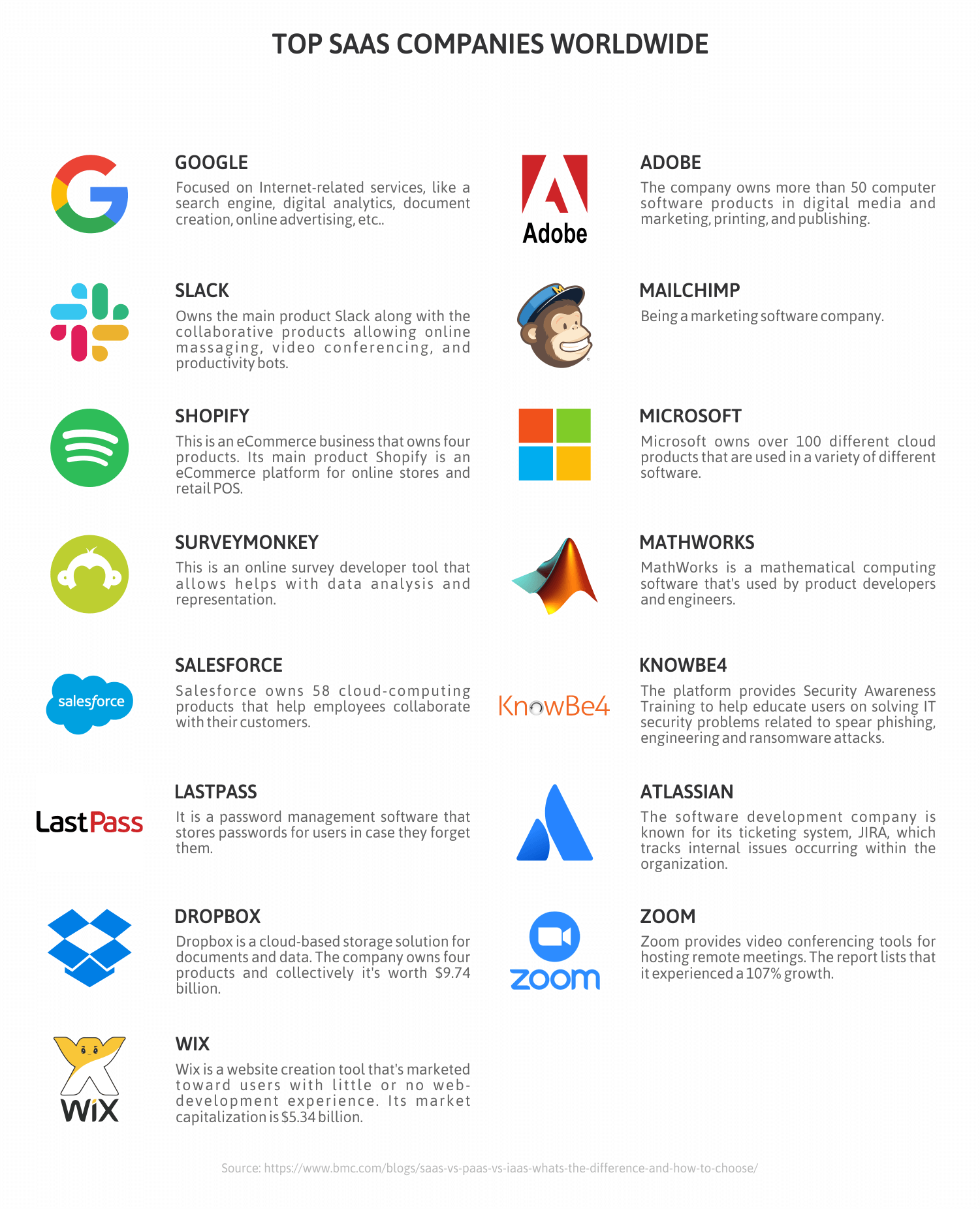
Conclusion
Software as a Service (SaaS) is a delivery model on a subscription basis and centralized hosting. The users have the ability to access the software via the web browser from different devices. SaaS is a runaway train that’s showing no signs of stopping. Companies use 16 SaaS apps on average today, up 33% from last year. 73% of organizations say nearly all (80%+) of their apps will be SaaS by 2020.
Last Updated on August 7, 2020.
